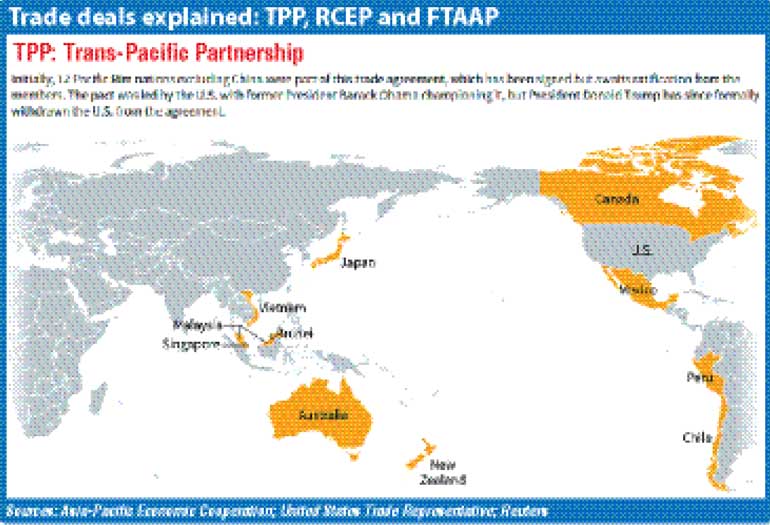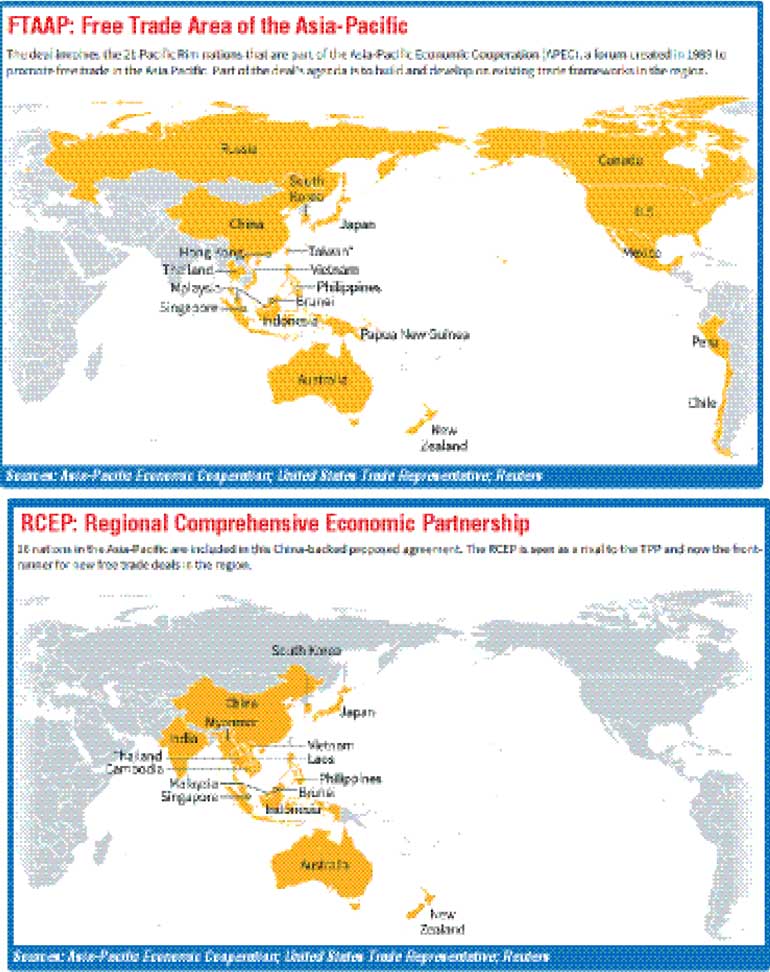Thursday Mar 13, 2025
Thursday Mar 13, 2025
Friday, 19 May 2017 00:00 - - {{hitsCtrl.values.hits}}
 Reuters: Japan and other remaining members of the Trans Pacific Partnership will this weekend decide how to revive the trade agreement ditched by US President Donald Trump.
Reuters: Japan and other remaining members of the Trans Pacific Partnership will this weekend decide how to revive the trade agreement ditched by US President Donald Trump.
Their trade ministers will talk on the sidelines of an Asia-Pacific Economic Cooperation (APEC) meeting in Hanoi, Vietnam, where newly appointed US Trade Representative Robert Lighthizer is also due to give more detail of Washington’s trade plans.
Uncertainty over those plans after Trump abandoned a trade deal he had compared to the “rape” of America has brought fears of protectionism and strengthened China’s leadership credentials in Asia.
Support has built among the so-called TPP-11 for pushing ahead without the United States although trade within the smaller block is only a quarter of that between the original 12 members, according to the most recent data.
Moving ahead could help the bargaining position of the members in bilateral talks with the United States.
It could also undercut the increasing regional dominance of China, which is not part of the TPP and backs a bigger but less comprehensive free trade agreement for Asia.
“We’ll be looking to see whether TPP ministers say they are definitely pushing ahead by simply by changing the articles,” said Alan Bollard, executive director of the APEC Secretariat.
“Or whether they come out and say they’re positive about the prospects but need more discussions,” he told Reuters in Hanoi.
After initially appearing reluctant to move ahead without the United States, Japan is at the forefront of the push along with New Zealand. Japan has emphasized that it would ultimately like to bring the United States back in.
On Tuesday, Prime Minister Shinzo Abe said Japan wanted to “steer the debate toward a clear direction” in Hanoi.
The backing of some other members is less clear.
Vietnam would have been one of the biggest beneficiaries of the original TPP because of lower tariffs and more investment from the United States. Malaysia is in a similar position and an official there voiced hope of an eventual return to the TPP.
Pushing TPP forward could help Japan’s position in negotiating a bilateral deal with the United States, said Nguyen Xuan Thanh of the Harvard Kennedy School. The same would apply for Vietnam, he said.
“It’s part of the game,” he told Reuters. “You don’t want to be seen as desperate for bilateral deals.”
New U.S. Trade Representative Lighthizer’s individual meetings with counterparts, particularly from the world’s second biggest economy, China, will be closely watched.
Mexico and Canada, with which Trump seeks to renegotiate their North American Free Trade Agreement are also in APEC.
Trump’s “America First” trade strategy relies on better enforcement of U.S. trade laws and existing trade agreements, while trying to negotiate some to the advantage of the United States.
Lighthizer has said he will make trade “freer and fairer” to the benefit of U.S. workers, farmers, ranchers and businesses.The final statement from APEC trade ministers will be scrutinized for any change to language which last year emphasised “free and open” trade and investment. It made no mention of the word “fair”.The renewed push on the TPP has somewhat overshadowed progress towards the Regional Comprehensive Economic Partnership (RCEP), championed by Beijing, and which members hope to sign by the end of the year.
The agreement includes both China and India, but not the United States. It is largely about reducing tariffs and much less comprehensive than TPP: it has limited protections for intellectual property, labor rights or the environment.
China would not be particularly happy to see TPP taking on new life even without the United States, said Tu Xinquan, a trade expert at Beijing’s University of International Business and Economics.
“I also don’t think China would or should take an action specifically responding to it,” he said.For the TPP to take effect without the United States it would have to drop a rule requiring ratification by at least six countries accounting for 85 percent of the combined gross domestic product of the original member nations.

Trade ministers from the Asia-Pacific Economic Cooperation (APEC) grouping will discuss various trade agreements or possible agreements around their meeting in Hanoi, Vietnam, this weekend.
Here is a rough guide to the agreements and how they compare.
Its future has been doubt since President Donald Trump withdrew the United States in one of his first acts as president, but Japan and others are now trying to get the 11 remaining members to push ahead. It does not include China.
It has been signed but awaits ratification by most members. Since the withdrawal of the United States, it is sometimes referred to as TPP-11 or TPP minus One.
Negotiations lasted nearly a decade on the wide-ranging agreement. It would cut most tariffs to zero and have wide impact on services and digital trade as well as goods. It includes strong protection for intellectual property and measures to protect labor rights and the environment.The flexibility of members is limited to areas where public health, animal health or public security could be at risk.
GDP: $8,897 b (vs. $25,559 b for TPP-12)
Population: 496 million (vs. 817 million for TPP-12)
Trade between members: $265 b ($1,014 b for TPP-12)
Members: Australia, Brunei, Canada, Chile, Japan, Malaysia, Mexico, New Zealand, Peru, Singapore, Vietnam (TPP-12 included the United States)
This free trade deal is backed by China and it has been given new impetus by the U.S. withdrawal from the Trans-Pacific Partnership. Members now hope to get it signed by the end of the year, although past targets have proved optimistic.At the core of RCEP are countries of the Association of South East Asian Nations, joined by China, India, Australia, New Zealand, Japan and South Korea.
It is less comprehensive than TPP and the main focus is reducing tariffs, although not as many would reach zero as under that other agreement. Coverage of services is more modest than for TPP. It would have no protection for labor rights or the environment. Although it might have provisions for greater freedom of movement, this is a sensitive issue.
Members would have greater flexibility in applying the agreement than is the case for TPP.
GDP: $21,490 billion
Population: 3,519 million
Trade between members: $1,937 b
Members: Brunei, Cambodia, Indonesia, Laos, Malaysia, Myanmar, the Philippines, Singapore, Thailand, Vietnam, China, Japan, South Korea, Australia, New Zealand, India
This is essentially an aspiration among the 21 Pacific Rim nations that are part of APEC, a forum created in 1989 to promote free trade in the Asia-Pacific region.
Part of the deal's agenda is to build and develop on existing trade frameworks in the region and to harmonise agreements. Both RCEP and TPP could be steps towards achieving the Free Trade Area of the Asia-Pacific.
GDP: $41,581 b
Population: 2,847 million
Trade between members: $5,547 b
Members: Russia, South Korea, Hong Kong, Japan, China, Taiwan, Vietnam, Philippines, Thailand, Malaysia, Brunei, Indonesia, Singapore, Australia, Papua New Guinea, New Zealand, Canada, United States, Mexico, Peru, Chile
n GDP figures are 2016 figures at constant prices, trade figures are for 2016, population figures are for 2015. Sources: IMF, World Bank
Discover Kapruka, the leading online shopping platform in Sri Lanka, where you can conveniently send Gifts and Flowers to your loved ones for any event including Valentine ’s Day. Explore a wide range of popular Shopping Categories on Kapruka, including Toys, Groceries, Electronics, Birthday Cakes, Fruits, Chocolates, Flower Bouquets, Clothing, Watches, Lingerie, Gift Sets and Jewellery. Also if you’re interested in selling with Kapruka, Partner Central by Kapruka is the best solution to start with. Moreover, through Kapruka Global Shop, you can also enjoy the convenience of purchasing products from renowned platforms like Amazon and eBay and have them delivered to Sri Lanka.
Discover Kapruka, the leading online shopping platform in Sri Lanka, where you can conveniently send Gifts and Flowers to your loved ones for any event including Valentine ’s Day. Explore a wide range of popular Shopping Categories on Kapruka, including Toys, Groceries, Electronics, Birthday Cakes, Fruits, Chocolates, Flower Bouquets, Clothing, Watches, Lingerie, Gift Sets and Jewellery. Also if you’re interested in selling with Kapruka, Partner Central by Kapruka is the best solution to start with. Moreover, through Kapruka Global Shop, you can also enjoy the convenience of purchasing products from renowned platforms like Amazon and eBay and have them delivered to Sri Lanka.